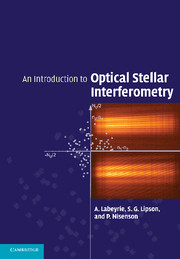Book contents
- Frontmatter
- Contents
- List of Illustrations
- Preface
- Peter Nisenson, 1941–2004
- 1 Introduction
- 2 Basic concepts: a qualitative introduction
- 3 Interference, diffraction and coherence
- 4 Aperture synthesis
- 5 Optical effects of the atmosphere
- 6 Single-aperture techniques
- 7 Intensity interferometry
- 8 Amplitude interferometry: techniques and instruments
- 9 The hypertelescope
- 10 Nulling and coronagraphy
- 11 A sampling of interferometric science
- 12 Future ground and space projects
- Appendix A
- Appendix B
- Index
12 - Future ground and space projects
Published online by Cambridge University Press: 23 February 2010
- Frontmatter
- Contents
- List of Illustrations
- Preface
- Peter Nisenson, 1941–2004
- 1 Introduction
- 2 Basic concepts: a qualitative introduction
- 3 Interference, diffraction and coherence
- 4 Aperture synthesis
- 5 Optical effects of the atmosphere
- 6 Single-aperture techniques
- 7 Intensity interferometry
- 8 Amplitude interferometry: techniques and instruments
- 9 The hypertelescope
- 10 Nulling and coronagraphy
- 11 A sampling of interferometric science
- 12 Future ground and space projects
- Appendix A
- Appendix B
- Index
Summary
Future ground and space projects
A few decades ago, there appeared to be two distinct evolutionary paths for astronomical imaging instruments: toward larger telescopes and longer-baseline interferometers. A telescope would be based on a single massive monolithic mirror, for which the limiting size appeared to be on the order of 8 m. An interferometer could involve two or more telescopes spaced tens or hundreds of meters apart, possibly up to ten kilometers. More recently, the emphasis in interferometers has turned to larger numbers of subapertures rather than larger sizes or longer baselines, in order to improve (u, v) coverage (e.g. the Magdalena Ridge Observatory Interferometer), and considerable effort is being devoted to planning space interferometers, which will be discussed later in this chapter (section 12.2). On the other hand, following the success of the mosaic mirror Keck telescopes of 10-m diameter, the elements of which are carried by a common pointing mount, projects for larger versions up to 100 m, are now being studied under the generic name “Extremely Large Telescopes” (ELT).
Alternative paths have also emerged. Mosaics of many smaller apertures are also being considered, at scales much larger than ELTs, these being diluted mosaics in which the problems of path-length compensation are overcome by designing the diluted optics as if it were a single giant telescope. In terms of their optical scheme, these mosaics may be considered as “exploded” versions of ELT's and they operate according to the hypertelescope principle (chapter 9).
Information
- Type
- Chapter
- Information
- An Introduction to Optical Stellar Interferometry , pp. 278 - 294Publisher: Cambridge University PressPrint publication year: 2006
